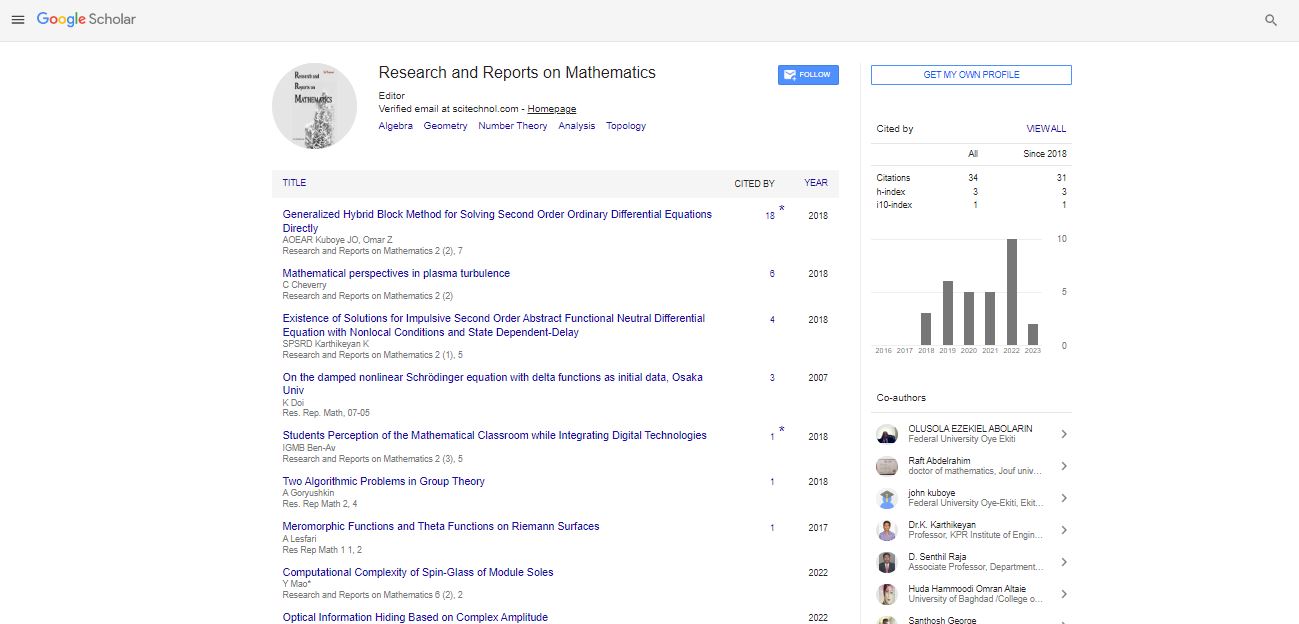Opinion Article, Res Rep Math Vol: 8 Issue: 1
Riemann's Legacy: Prime Number Distribution and Modern Mathematics
Shik Bum*
Department of Mathematics, University of Mainz, Mainz, Germany
- *Corresponding Author:
- Shik Bum
Department of Mathematics,
University of Mainz,
Mainz,
Germany
E-mail: shikbum123@gmail.com
Received date: 27 October, 2023, Manuscript No. RRM-23-118493;
Editor assigned date: 30 October, 2023, PreQC No. RRM-23-118493 (PQ);
Reviewed date: 13 November, 2023, QC No. RRM-23-118493;
Revised date: 11 January, 2024, Manuscript No. RRM-23-118493 (R);
Published date: 18 January, 2024, DOI: 10.4172/rrm.1000221
Citation: Bum S (2024) Riemann's Legacy: Prime Number Distribution and Modern Mathematics. Res Rep Math 8:1.
Description
The Riemann hypothesis, formulated by the legendary mathematician Bernhard Riemann in 1859, continues to be one of the most significant unsolved problems in mathematics. The historical context, the hypothesis itself, its implications for prime number distribution, and its relevance to modern mathematics. By exploring the Riemann hypothesis, we unravel a complex web of mathematical concepts and the profound impact it has had on various branches of mathematics. The Riemann hypothesis, an unproven conjecture, centers on the distribution of prime numbers and their correlation with the nontrivial zeros of the Riemann zeta function. The hypothesis posits that all these nontrivial zeros lie on a specific line in the complex plane, known as the critical line. If true, it would revolutionize our understanding of prime numbers and further influence a multitude of mathematical subfields.
The Riemann hypothesis stands as a monumental challenge in number theory. Its connection to prime number distribution has ignited curiosity among mathematicians for over a century. In this manuscript, we embark on a journey to understand Riemann's legacy and its influence on modern mathematics.
Bernhard Riemann's groundbreaking work emerged during the 19th century, a time of intense mathematical exploration. The foundation of complex analysis was being laid, and Riemann was a key figure in this endeavor. He introduced the Riemann zeta function, ζ(s), as a tool to explore the distribution of prime numbers. The zeta function's analytic continuation became central to his hypothesis.
The Riemann hypothesis
At its core, the Riemann hypothesis postulates that all non-trivial zeros of the Riemann zeta function lie on the critical line, Re(s)=1/2. This implies a deep connection between the distribution of prime numbers and the behavior of this complex function. Proving or disproving the hypothesis has been a challenge that has endured for more than 150 years.
The prime number theorem, independently proved by Hadamard and de la Vallee Poussin in 1896, confirmed the importance of the Riemann hypothesis. It states that the distribution of prime numbers is asymptotically related to the behavior of the Riemann zeta function. The Hypothesis provides a conjectural explanation for this connection.
Implications for modern mathematics
The Riemann hypothesis transcends the realm of prime number theory. Its profound implications ripple through various branches of mathematics:
The hypothesis has left an indelible mark on complex analysis, leading to the study of zeta functions and L-functions. The understanding of their properties has found applications in other areas of mathematics.
Number theory
While the Hypothesis itself is a conjecture about prime numbers, its connections with Dirichlet L-functions and other number-theoretic objects have broadened its influence in the field.
The concept of zeta functions has had profound implications in algebraic geometry, leading to developments like the Weil conjectures.
Surprisingly, the Riemann zeta function and the Riemann hypothesis have found connections in quantum mechanics, with certain physical systems exhibiting behavior analogous to non-trivial zeros of the zeta function.
The Riemann hypothesis remains unsolved, presenting one of the greatest challenges in mathematics. It continues to attract the attention of mathematicians and has spurred the development of numerous techniques and theorems.
Conclusion
Riemann's Legacy is not confined to prime number distribution; it is a testament to the interconnectedness of mathematical disciplines. The pursuit of the Riemann hypothesis has expanded our understanding of number theory, complex analysis, and diverse fields within modern mathematics. Its influence endures, and its resolution remains one of the most sought-after goals in mathematical research.
As we reflect on the enduring legacy of Bernhard Riemann and his profound conjecture, we find that the Riemann hypothesis not only challenges the boundaries of mathematical knowledge but also exemplifies the beauty and depth of mathematical exploration. It is a testament to the unquenchable curiosity that drives the mathematical community forward, forever seeking to unlock the secrets of the primes and their distribution in the intricate landscape of number theory.
 Spanish
Spanish  Chinese
Chinese  Russian
Russian  German
German  French
French  Japanese
Japanese  Portuguese
Portuguese  Hindi
Hindi 